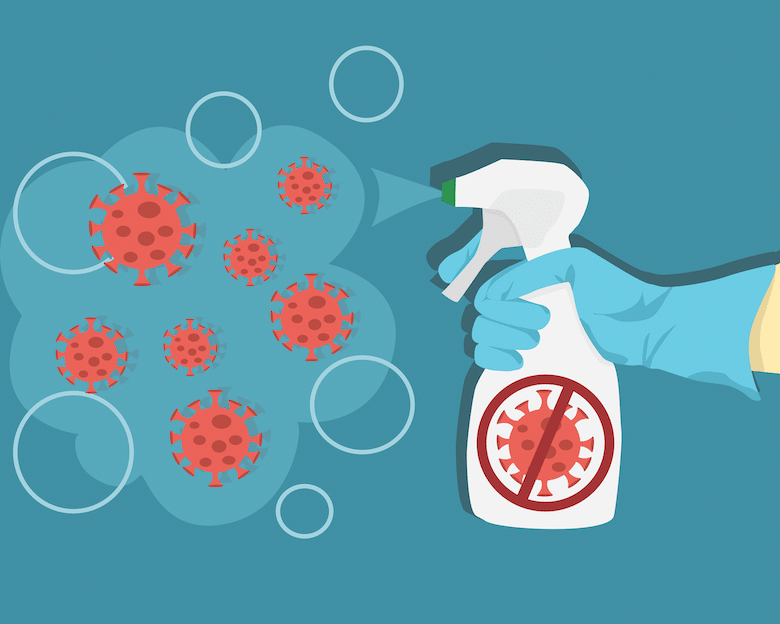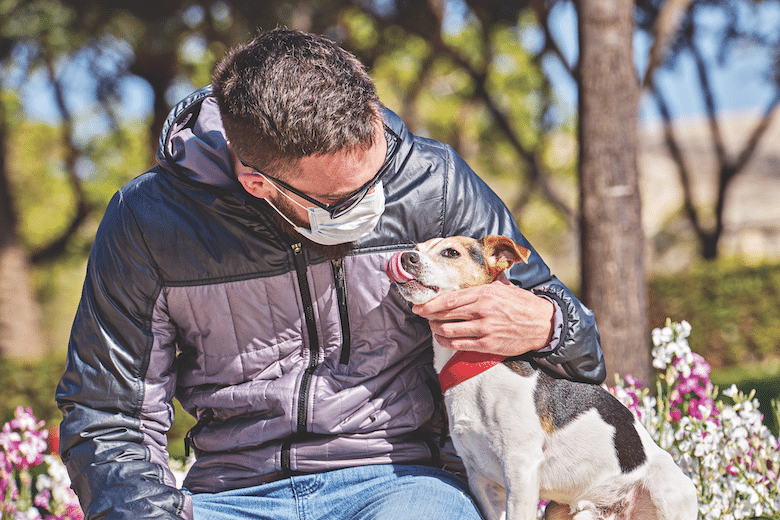While we have a good understanding of COVID-19 in dogs, there’s still much to learn. Let’s examine some common canine COVID-19 questions and offer solid advice on how to keep your dog safe.
What we know now about COVID-19 and dogs
In early 2020, a smattering of reports emerged from Asia and Europe citing a few dogs apparently had contracted COVID-19. Chinese researchers quickly proved that dogs, cats and ferrets could become experimentally infected with SARS-CoV-2. A handful of canine COVID-19 cases were verified in the United States a few months later.
The undisputed fact is that dogs, cats, ferrets and hamsters can become infected with the novel coronavirus. Most of the infected dogs were reported to have clinical signs similar to human COVID-19 including fever, difficulty breathing and GI upset. In every case, transmission to the dog or cat was believed to be from an infected human living in the home. As of publication, there have been no confirmed cases of dog-to-dog or dog-to-human transmission in a normal household setting anywhere in the world.
The scientific conclusion at this point is that dogs pose little, if any, threat of spreading COVID-19 to humans.
In fact, we present a much more significant risk of transmitting SARS-CoV-2 to our dogs. If anyone in your home becomes infected with COVID-19, quarantine them from your pets as well as other family members until cleared by their physician.
Risk for brachycephalics
Are brachycephalic breeds (smushed-faced) like Pugs or Bulldogs at greater risk of contracting coronavirus? Brachycephalics are at risk of breathing complications if they develop any respiratory infection; however, they are not at increased risk for COVID-19 infection. Based on the 2003 coronavirus pandemic and current coronavirus research, the overwhelming consensus is that COVID-19 is extremely rare in any dog, regardless of breed, age or gender.
Around other dogs
Is it safe to visit a dog park or take walks and play with other dogs? In general, my recommendation is to practice social distancing for both yourself and your dog during outings. Keeping a safe distance of at least 6 feet from unknown dogs (or people) is my suggestion based on an abundance of caution. Social distancing for dogs is arguably more about keeping humans safe from SARS-CoV-2 than their canines.
Hypothetically, an infected person could transfer coronavirus to their dog, and then those viral particles could infect you if you then pet the dog. Once again, it’s important to remember that there have been no reported cases of naturally occurring dog-to-dog or dog-to-human transmission of COVID-19 anywhere in the world.

Simple precautions
Proper pandemic petiquette practices include keeping you and your dog a safe distance from others, discouraging strangers from petting or physically contacting your dog whenever possible, keeping your dog closely supervised when outside or in public and thoroughly washing your hands after touching any dog or cat.
If your dog interacts with a person or dog you don’t know, I recommend bathing your dog as soon as possible and limiting access to beds, couches or other shared spaces until after bath time. Call me paranoid, but as a veterinarian, we’re experts in preventing and limiting disease transmission.
Related: Have a New Puppy? Here’s how to Socialize Your Dog While Social Distancing
Right now, that means taking extra precautions and spending a little more time in the tub with the Terriers. I’m personally still walking and taking them out in public, and they’ve even had a few playdates with doggie friends whose pet parents we know and trust.
And please don’t put a mask on your dog (or cat). It will only create additional stress on them and provides relatively little protective benefit to others. Besides, good luck keeping it on for more than a few minutes!
Disinfecting do’s & don’ts
There has been a tremendous amount of confusion on how to disinfect and clean your house if you have dogs. First, carefully read the label of whatever disinfectants you’re using. Most will declare if they pose a risk to pets or children. Next, use common sense: Cleaners used on surfaces aren’t meant to clean sensitive skin, especially a dog’s. Veterinarians are seeing a surge in dogs with serious skin reactions due to being wiped down by counter wipes.
Related: 6 Household Cleaning Products That Are Not Safe for Dogs
Disinfectants proven to be effective against SARS-CoV-2 include rubbing alcohol; 0.5% hydrogen peroxide; and diluted bleach (5 tablespoons 5.25% to 8.25% sodium hypochlorite per gallon of room temperature water). All of these cleaning agents can be toxic to dogs if they drink them or even just lick excessive amounts. These disinfectants can also cause severe injury if they contact the eyes, mouth, nose or skin. It only takes a drop of bleach solution to cause tremendous injury to a dog’s eye. If you think your dog has accidentally ingested or contacted any cleaning product, contact your veterinarian or the ASPCA’s Animal Poison Control center immediately. (888-426-4435)
Dog shampoo and clean water are all you need to disinfect your dog. I can’t believe I have to say this, but never give dogs bleach solution to drink or rinse their mouth. Yes, it’s a thing. And dogs are getting poisoned from it.
The bottom line: It is extremely rare for dogs, or any pet, to contract COVID-19. It’s even less likely a dog will transmit SARS-CoV-2 to a person or other animal. There is a slight risk of an infected pet parent spreading COVID-19 to a pet, so keep anyone infected away from all dogs, cats and people until the virus has passed. Practice safe social distancing when out with your dog, and wash your hands after contact with any pet. Stay safe and give your dogs a hug from me!
Featured Image: Kira-Yan | Getty Images
Read Next: Can Dogs Detect COVID-19?






